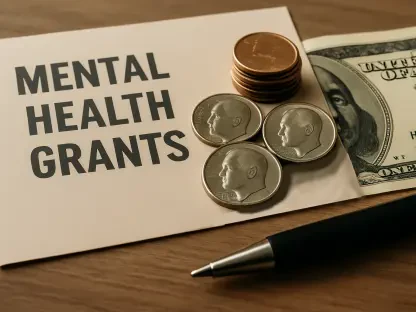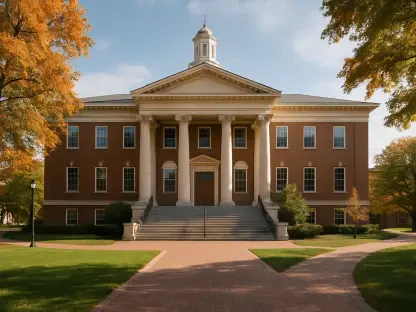The financial world of higher education stands at a critical juncture as university endowments, often seen as pillars of academic stability, face an unprecedented challenge with a looming tax overhaul set to hit in 2026. With endowments over $1 billion boasting an impressive average return of 11.5% in fiscal year 2025, this success is overshadowed by a tiered tax system, escalating up to 8% for the wealthiest funds, which could redirect hundreds of millions annually from academic missions to government coffers. This roundup gathers diverse perspectives from financial analysts, university administrators, and policy experts to unpack how these changes might reshape the landscape of university funding. The aim is to provide a comprehensive view of the potential impacts, strategies, and debates surrounding this pivotal issue.
Understanding the Tax Overhaul: A Spectrum of Opinions
Financial Analysts Weigh In on the Numbers
Financial experts have been quick to highlight the stark contrast between recent endowment gains and the upcoming fiscal burdens. Many point out that while the 11.5% average return in 2025 reflects savvy investments in private equity and venture capital, the new tax structure could erode these achievements. Projections suggest that top-tier institutions might face annual tax bills in the range of $300 million, a figure that could force significant budgetary recalibrations.
Analysts also note that smaller endowments, though facing lower absolute costs, may struggle more proportionally. The consensus among these professionals is that universities must rethink investment portfolios to prioritize tax-efficient strategies. Some suggest a shift toward assets with lower taxable gains, though this could mean sacrificing the higher returns that have driven recent success.
A third perspective focuses on historical adaptability. Financial advisors recall how endowments have navigated past market downturns through diversification, suggesting that similar resilience might be key. However, they caution that a tax burden of this magnitude is a different beast, requiring not just financial but also political maneuvering to mitigate.
University Administrators Voice Operational Concerns
Administrators from various institutions express deep apprehension about the operational fallout of the tax increase. Many emphasize that funds previously allocated to financial aid, research initiatives, and faculty support could be drastically reduced. The fear is palpable that students, particularly those reliant on scholarships, will bear the brunt of these financial constraints.
Another angle from campus leaders highlights preemptive actions already underway. Some universities have begun trimming staff and programs to brace for the fiscal hit expected in 2026. This proactive, albeit painful, approach is seen as necessary to maintain core academic functions, though it raises questions about long-term institutional health.
A divergent view among administrators is the potential for innovation under pressure. Certain leaders argue that this challenge could spur alternative revenue streams, such as enhanced alumni fundraising or public-private partnerships. While optimistic, this perspective acknowledges the steep uphill battle in offsetting such significant revenue losses through untested methods.
Policy Experts Debate Fairness and Intent
Policy analysts bring a broader lens to the discussion, focusing on the rationale behind the tiered tax system. Supporters within this group argue that endowments, often viewed as vast pools of untapped wealth, should contribute more to public revenue needs. They contend that the escalating rates, peaking at 8% for the highest per-student valuations, are a justified means to address national fiscal priorities.
On the opposing side, critics within policy circles decry the potential harm to educational missions. They argue that siphoning off endowment returns risks undermining access to quality education and cutting-edge research, areas where universities play a vital role. This camp often calls for exemptions or caps to protect academic priorities over government gain.
A middle-ground perspective suggests a need for dialogue between policymakers and universities to refine the tax structure. Some experts advocate for tiered exemptions based on endowment usage, such as funds explicitly directed toward student aid. This balanced approach seeks to address revenue needs while safeguarding the core purposes of higher education funding.
Strategies to Weather the Fiscal Shift
Investment Adjustments for Tax Efficiency
Insights from investment consultants underscore a growing trend toward recalibrating endowment portfolios. Many recommend reducing exposure to high-gain, high-tax assets in favor of more stable, tax-advantaged options. While this may dampen returns compared to the robust 11.5% seen in 2025, it could provide a buffer against the fiscal strain starting in 2026.
A contrasting tip from other financial strategists is to double down on lobbying efforts alongside investment shifts. They argue that influencing policy revisions or securing tax relief could be as impactful as any portfolio adjustment. This dual strategy of financial and political action is seen as a pragmatic way to navigate the uncertainty.
Additionally, some advisors push for transparency in communicating these shifts to stakeholders. They suggest that universities openly discuss potential changes in investment approaches with students and faculty to manage expectations about funding for programs and aid. This openness could foster trust during a period of inevitable belt-tightening.
Enhancing Revenue Diversification
University financial officers offer varied tips on diversifying income to lessen reliance on endowment returns. A common suggestion is ramping up alumni engagement campaigns to boost donations, leveraging the current economic success to appeal to donors’ sense of legacy. This approach aims to create a more sustainable funding base amid tax pressures.
Another strategy gaining traction is exploring commercial ventures or partnerships with industry. Some administrators highlight potential in licensing intellectual property or hosting corporate research hubs on campus. While not without risks, such initiatives could provide a financial lifeline for institutions facing steep tax bills.
A less conventional idea is rethinking tuition models to include more flexible payment structures or micro-credential programs. Certain experts believe that adapting educational offerings to market demands could attract new student demographics, thereby increasing revenue. This forward-thinking tactic, however, requires careful planning to avoid compromising academic integrity.
Advocacy and Policy Engagement
Policy advocates and university coalitions stress the importance of collective action in response to the tax changes. Many recommend forming alliances to lobby for amendments that might soften the blow, such as phased implementation or specific carve-outs for endowments funding critical areas like student support.
Differing opinions within this space focus on public awareness campaigns. Some suggest that universities should educate communities about the downstream effects of these taxes on local economies and educational access. Building public support could pressure policymakers to reconsider the scale of the tax hike.
A final piece of advice centers on internal policy alignment. Experts urge institutions to align their advocacy with clear, data-driven arguments about how endowment funds directly benefit society through research and education. Crafting a compelling narrative could be a powerful tool in negotiations with government bodies over the coming years.
Reflecting on the Collective Wisdom
Looking back on this roundup, the dialogue around the impending tax changes for university endowments reveals a complex tapestry of concern, strategy, and debate. Financial analysts provided sobering projections and pragmatic investment advice, while administrators shared raw insights into the operational challenges that unfold as 2026 approaches. Policy experts added depth by framing the issue within larger questions of fairness and public good. For the future, universities are encouraged to consider a multi-pronged approach: adjust investment strategies for tax efficiency, explore diverse revenue sources beyond traditional endowments, and engage actively in policy advocacy to shape a more favorable outcome. As the fiscal landscape continues to evolve, staying informed through ongoing discussions and resources on higher education funding will be crucial for all stakeholders navigating this challenging terrain.









